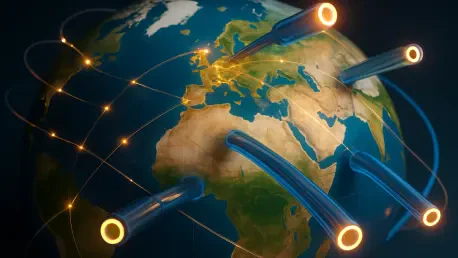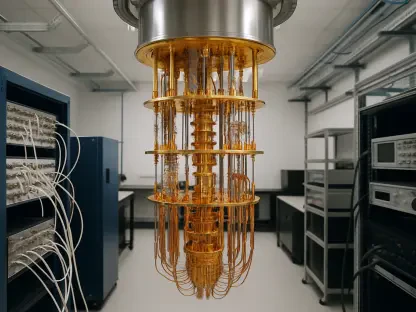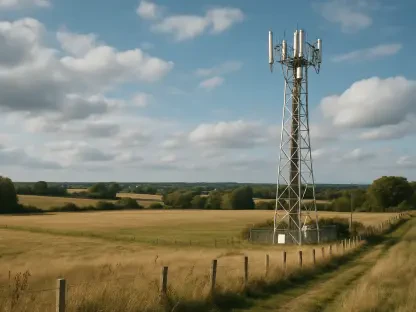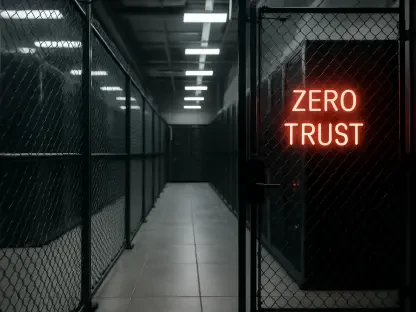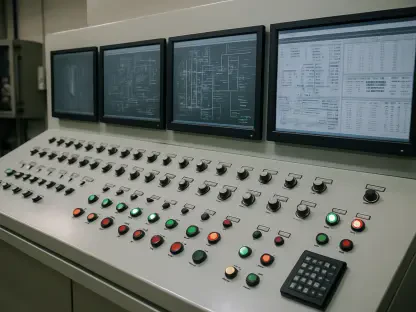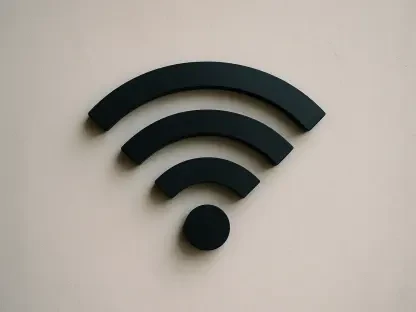In an era where digital transformation is accelerating at breakneck speed, the backbone of global connectivity—optical fiber networks—is straining under the weight of unprecedented data demands driven by artificial intelligence, cloud computing, and advanced mobile technologies like 5G. Traditional glass-core fibers, long the standard for transmitting data across vast distances, are increasingly encountering limitations such as signal loss, latency, and distortion, which threaten to bottleneck the future of communication. Enter hollow-core fiber (HCF), a pioneering technology that challenges the status quo by guiding light through an air-filled core rather than solid glass, offering the tantalizing promise of faster speeds and significantly reduced latency. This innovation could potentially redefine how data travels across the globe, impacting everything from hyperscale data centers to transoceanic internet cables. As industries grapple with the need for more efficient networks, HCF emerges as a possible game-changer, sparking curiosity about whether it can truly transform the infrastructure that underpins modern connectivity.
Unpacking the Innovation Behind Hollow-Core Fiber
Hollow-core fiber represents a radical departure from the conventional design of optical cables that have dominated telecommunications for decades. By replacing the solid glass core with an air-filled channel, HCF allows light to travel at a faster pace due to air’s lower refractive index compared to glass, thereby slashing latency and minimizing signal distortion. This breakthrough has been made possible through cutting-edge designs like antiresonant reflecting fibers, which utilize delicate glass membranes to confine light within the core with impressive precision. Such advancements, spearheaded by companies like Lumenisity, now integrated into Microsoft’s ecosystem, highlight the practical strides being made. The shift from theory to application marks HCF as a serious contender in the quest for next-generation network solutions, raising important questions about its scalability and real-world impact on data transmission standards.
Beyond the mechanics, the scientific community has played a pivotal role in refining HCF’s potential through rigorous research and theoretical modeling. Scholars at institutions like the University of Bath have developed detailed explanations for why specific HCF structures achieve remarkably low data loss, blending academic insight with engineering progress. This synergy between conceptual understanding and tangible innovation underscores the technology’s readiness to address longstanding challenges in optical communication. Unlike traditional fibers, where physical constraints often limit performance, HCF opens up new possibilities for high-speed, low-latency connections that could support the ever-growing demands of digital infrastructure. As these developments unfold, attention naturally turns to how these theoretical advantages translate into measurable benefits across diverse applications, from urban data hubs to global internet links.
Real-World Advantages and Transformative Applications
The standout benefits of hollow-core fiber lie in its ability to deliver reduced latency, enhanced data speeds, and cleaner signal transmission by mitigating nonlinear effects that plague glass-core fibers. These attributes are particularly crucial for sectors where timing is everything, such as artificial intelligence platforms that require instantaneous data processing or high-frequency financial trading systems where milliseconds can determine profit or loss. Early deployments have already demonstrated compelling results, with Microsoft reporting up to a 47% increase in data speeds within its Azure data centers when utilizing HCF. Such outcomes suggest that the technology is not merely a futuristic vision but a practical solution poised to address the escalating needs of modern networks, especially in environments where performance is non-negotiable.
Further evidence of HCF’s capabilities comes from extensive trials conducted by industry leaders like China’s Yangtze Optical Fiber and Cable (YOFC), which achieved record-breaking transmission rates over significant distances. These experiments, pushing terabit-level speeds across multi-kilometer spans, underline the technology’s suitability for long-haul applications like undersea cables that form the backbone of global internet connectivity. The implications are profound, as HCF could enable error-free, high-capacity data transfer across continents with minimal signal boosting, reducing both operational costs and energy consumption. As these real-world validations accumulate, the focus shifts to whether the technology can overcome practical barriers to become a staple in telecommunications, paving the way for broader adoption across varied and demanding use cases.
Navigating the Roadblocks to Widespread Adoption
Despite its impressive potential, hollow-core fiber faces significant challenges that could slow its integration into mainstream network infrastructure. The manufacturing process for HCF is notably complex and expensive, requiring meticulous precision to create the intricate structures that guide light through air rather than glass. This complexity not only drives up costs but also limits production scalability, posing a barrier for network operators considering large-scale deployment. Additionally, the lighter and more fragile nature of HCF compared to traditional fibers complicates installation, especially in rugged or remote environments where durability is paramount. These operational hurdles highlight the need for innovative solutions to make HCF a feasible option for widespread use.
Economic considerations further cloud the path to adoption, as the high upfront investment in HCF technology may deter stakeholders despite the promise of long-term savings through reduced energy needs and lower maintenance. Technical challenges, such as the difficulty of fusion splicing HCF segments with minimal signal loss, also persist, though ongoing advancements in specialized techniques and ruggedized cable designs offer hope for resolution. The balance between initial costs and future benefits remains a critical decision point for industry players, who must weigh the transformative potential of HCF against immediate financial realities. As research and development efforts continue to tackle these issues, the timeline for mass integration remains uncertain, prompting a cautious yet optimistic outlook on the technology’s trajectory.
Overcoming Testing and Integration Challenges
Implementing hollow-core fiber in existing networks demands a rethinking of traditional testing and troubleshooting methodologies, as the unique properties of HCF present distinct obstacles. Conventional tools like optical time domain reflectometry (OTDR), used to locate faults and measure signal loss, struggle with the reduced Rayleigh backscatter in HCF, where light travels through air instead of glass, often resulting in weaker diagnostic signals. This limitation complicates fault detection and network maintenance, necessitating the development of specialized equipment tailored to HCF’s characteristics. Fortunately, progress in this area is underway, with next-generation OTDR devices incorporating ultrasensitive infrared sensors to enhance accuracy and reliability in evaluating HCF performance.
Beyond diagnostics, ensuring seamless integration with current infrastructure is another hurdle that industry innovators are addressing. The compatibility of HCF with established systems, particularly through the use of familiar wavelengths and protocols, minimizes the learning curve for technicians and reduces the need for extensive retraining. Advanced digital filtering and noise rejection techniques in testing tools further support precise calibration, ensuring that HCF networks can be monitored effectively without disrupting operational continuity. These advancements reflect a broader commitment to balancing cutting-edge technology with practical deployment, smoothing the transition for network operators. As these solutions mature, they pave the way for HCF to be integrated into diverse environments, from urban data centers to long-distance communication lines, without compromising on reliability or efficiency.
The Strategic Role of the 1550 nm Wavelength
A cornerstone of hollow-core fiber’s viability lies in its alignment with the 1550 nm wavelength, a standard in optical communications known for its minimal signal attenuation and robust compatibility with existing network components. This wavelength, situated within the C-band, ensures low loss over long distances and supports high data rates while maintaining signal integrity through manageable chromatic dispersion. Its adoption in HCF systems facilitates a smoother integration with legacy infrastructure, including transceivers and multiplexing technologies, reducing the barriers to entry for operators looking to upgrade their networks. This strategic alignment positions the 1550 nm wavelength as a linchpin in making HCF a practical choice for widespread deployment.
Moreover, the 1550 nm wavelength offers additional advantages in terms of safety and performance optimization within HCF applications. Its use in infrared transmission minimizes risks during installation and maintenance, adhering to global laser safety standards and protecting technicians from potential hazards. High-sensitivity sensors, such as indium gallium arsenide photodiodes, further enhance HCF’s capabilities at this wavelength by providing low-noise detection, which is critical for maximizing bandwidth and minimizing latency. This combination of safety, compatibility, and efficiency underscores why the 1550 nm wavelength is not just a technical detail but a foundational element in the push for HCF adoption. As the industry moves forward, this wavelength will likely remain central to ensuring that HCF can scale effectively across diverse network environments.
Global Traction and a Vision for the Future
Across the globe, hollow-core fiber is gaining traction as major technology players invest in pilot projects and refine manufacturing techniques to bring this innovation to market. Companies like Microsoft and YOFC are at the forefront, conducting trials that demonstrate HCF’s ability to handle massive data loads with unprecedented efficiency, from data center enhancements to long-distance transmission records. These initiatives signal a growing confidence in HCF’s potential to address the limitations of current optical networks, particularly as data demands continue to surge. Concurrently, industry groups are prioritizing standardization efforts to establish performance benchmarks and interoperability guidelines, which are essential for fostering a competitive supply chain and encouraging broader adoption.
Looking ahead, the vision for HCF extends far beyond incremental improvements, with projections suggesting the development of ultralong-haul cables capable of spanning over 10,000 kilometers, revolutionizing transoceanic connectivity by drastically cutting latency and boosting capacity. Such advancements could lay the groundwork for future technologies like 6G networks and quantum communications, positioning HCF as a foundational element in the next wave of digital innovation. While tempered by the recognition of technical and economic challenges, this optimistic outlook reflects a collective belief in HCF’s transformative power. The path forward will depend on collaborative efforts to overcome existing barriers, ensuring that this technology can fulfill its promise of redefining how the world stays connected in an increasingly data-driven era.
Charting the Path Ahead for Network Evolution
Reflecting on the journey of hollow-core fiber, it’s evident that this technology has carved out a significant niche by addressing critical shortcomings of traditional optical fibers through superior speed and reduced latency, as validated by pioneering trials from industry giants like Microsoft and YOFC. The strategic use of the 1550 nm wavelength has ensured compatibility and safety, while innovations in testing tools have begun to resolve integration challenges. Yet, obstacles in manufacturing costs and installation fragility have tempered the pace of adoption, requiring sustained effort to bridge the gap between potential and reality. Moving forward, the focus must shift to actionable strategies—accelerating standardization, investing in scalable production methods, and refining ruggedized designs to ease deployment. Collaborative initiatives between tech leaders and research bodies will be crucial in navigating these complexities, ensuring that HCF can anchor the infrastructure for emerging technologies like 6G and beyond. This balanced approach, grounded in past achievements and future-oriented solutions, offers a roadmap for transforming global connectivity.
